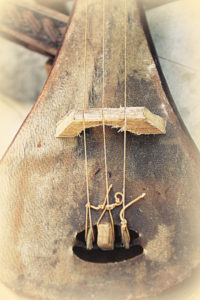One of the most popular and ever present instruments in our youth culture today is the guitar. We all know what a guitar sounds and looks like, but have you ever wondered where they came from? The guitar, through quite a few permutations, is a distant cousin of the lute.
The Lute
In the Middle Ages the lute was a very popular and ubiquitous instrument. It was most popular between the years 1400 and 1700. The Harvard Dictionary of Music defines the lute as “a plucked string instrument with a round body in the shape of a halved pear, a flat neck with seven or more frets and a separate peg-box set perpendicular to the neck.” The lute is played by plucking the strings with the fingers or plectrum (pick).
There are two main types of early lutes: the long neck, with a neck longer than the body, and a short-neck, that is shorter than the body. The lute first appeared around 2,000 BC on Mesopotamian figurines.
The European style lute descended from the Arabian Ud (an ancient and modern lute, of the near east). It was present in Europe during the Moorish occupation of Spain from the years 711-1492 AD. Illustrations demonstrate that non-Moors were playing it from the 13th Century on.
“During the Renaissance, the lute, like other instruments, evolved into a family of different sizes and pitch ranges, corresponding to those of the human voice,” wrote John Stanley in his book, Classical Music.
Lute Music
The sound of the lute is similar to the guitar. This music, in the 16th and 17th Centuries, was of paramount importance as it was secondary instrumental music only to the organ and harpsichord. During the 16th century the lute was the most popular instrument played in the home, much like the piano is today.
In the late Baroque period the renowned composer, J. S. Bach, wrote pieces for the lute. In 1530 and beyond there was a large number of printed lute books and manuscripts written by many European composers.
John Dowland (1563-1626) from England was a virtuoso lutenist, song composer and singer, whose works were harmonically advanced for their time. In the late 16th Century the lute was a favorite instrument to accompany songs. In England a distinctive song was developed: The Ayre – a song for solo voice, lute, and other instruments. Dowland excelled in writing Ayres. His four books of Ayres (1597-1612) were widely published and became extremely popular. Dowland reached star-status in his day.
Troubadours, Trouveres & Minnesingers
They were important groups of itinerant musicians who spent their lives traveling and roaming all over Europe during the Middle Ages. The Troubadours were poet-musicians who belonged to the nobility. They flourished in southern France from the 11th to the 13th Century.
They primarily performed songs about courtly love and everyday issues of politics and morals. The Troubadours were pioneers in Western European history and established a tradition of performing songs in their native language. Most of the music was monophonic (a single line of melody with no harmony) as opposed to Polyphony (with two or more independent melodic lines).
The Trouveres were much like the Troubadours except they were from northern France and flourished in the 13th Century.
The Minnesingers were German singers of aristocratic noble birth.
They were poet musicians who flourished in Germany during the Middle Ages. Quite similar to the French Troubadours, they sang of courtly love and romance. Some of the texts differ in content from the Troubadours and are more narrative than amorous.
The Minnesingers became the leading performers of German music in the Middle Ages. The singers were superseded by the merchant-class Meistersingers of the 15th and 16th Centuries. All three of these poet-musician groups used the lute as one of their instruments.
The Mandolin
 The newest instrument of the lute family is the mandolin; interestingly it is the only one in wide use in circulation today. The mandolin’s construction is similar to the lute. It has a round back that is characteristic of the lute. Some say it has a “pot belly.”
The newest instrument of the lute family is the mandolin; interestingly it is the only one in wide use in circulation today. The mandolin’s construction is similar to the lute. It has a round back that is characteristic of the lute. Some say it has a “pot belly.”
The instrument is sometimes called the “Neapolitan mandolin” because it is often used in southern Italy. It has four double courses (eight steel strings) that are tuned in pairs. It is played with a plectrum made of shell or other material that is somewhat flexible. Compositions for mandolin appeared around 1700.
On rare occasions the mandolin is used in the symphony orchestra. Many notable composers have written for mandolin. George Frederick Handel included it in his oratorio Alexander Ballus; Wolfgang Mozart’s Don Giovanni; Verdi’s Othello; Beethoven’s Four Pieces for Mandolin & Piano; and more recent works by Schoenberg’s Serenade and Stravinsky’s Agon.
The mandolin is used extensively in folk music, blue grass, country and other indigenous music of the people. The sound of the mandolin is somewhat similar to today’s banjo.
Today, it is very rare to see the lute being played, except in small ensembles that specialize in music of the Middle Ages and the Renaissance. These groups use authentic instruments of those eras.
In some universities a group called Collegium Musicum within the department of music, has an ensemble devoted to the preservation and cultivation of ancient music. Locally, my alma mater, the University of California at Berkeley, has such a group.
It is very interesting to see and hear ancient music played on authentic instruments from this period; an uncommon sound in today’s world.
Don’t miss “Fifteen” the Danville Community Band’s Annual Spring Concert,
Saturday, June 10 2017, 3 p.m. at the Lesher Center for The Arts, 1601 Civic Dr., Walnut Creek. Celebrating our 15th Anniversary, this delightful event will present a music mix for everyone’s taste. Go to our website, www.danvilleband.org for information, selection titles and ticket sales. Tickets on sale now! Call Lesher Box Office, 943-7469 noon-6:00 p.m. Please submit your questions and comments to banddirector01@comcast.net. Visit our website at www.danvilleband.org for up-to-date information about the Danville Community Band.






